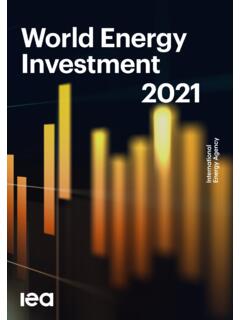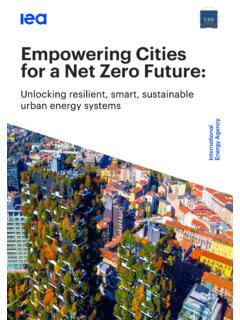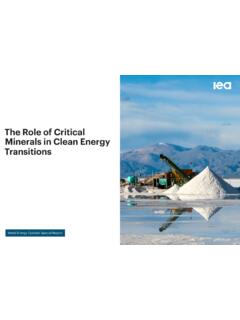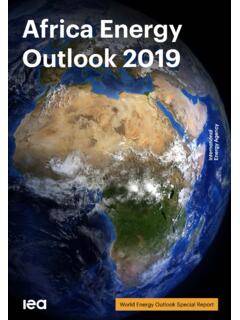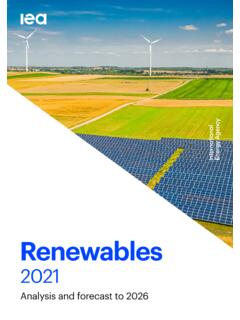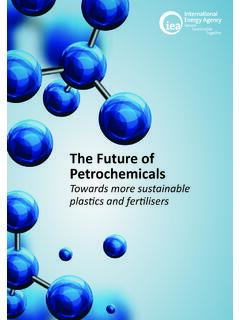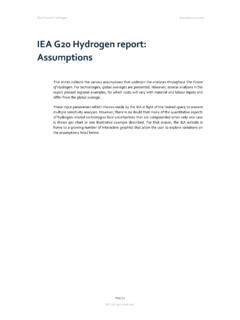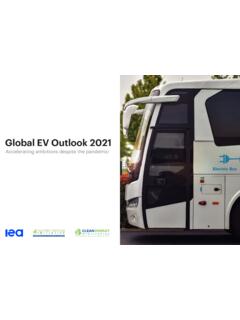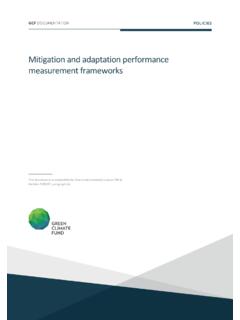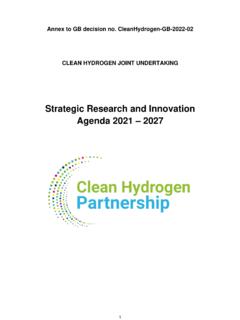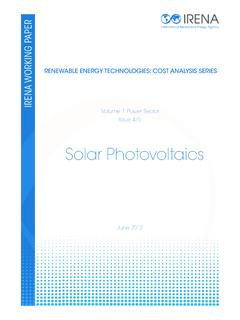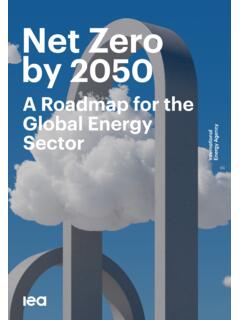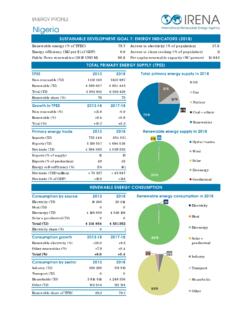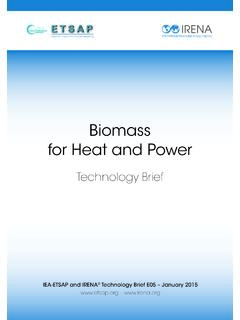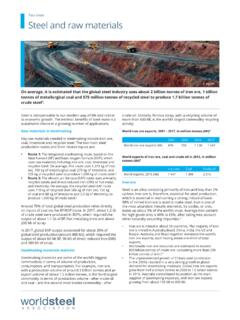Transcription of Key World Energy Statistics 2021 - iea.blob.core.windows.net
1 Statistics reportKey World Energy Statistics 2021 September 2021 KEY World Energy Statistics Please note that this publication is subject to specific restrictions that limit its use and distribution. The terms and conditions are available online at : IEA. All rights Energy agency Website: Austria BelgiumCanadaCzech Republic DenmarkEstoniaFinland France Germany Greece HungaryIreland ItalyJapanKorea Luxembourg Mexico Netherlands New Zealand NorwayPoland Portugal Slovak Republic Spain Sweden Switzerland Turkey United Kingdom United StatesINTERNATIONAL Energy AGENCYThe IEA examines the full spectrum of Energy issues including oil, gas and coal supply and demand, renewable Energy technologies, electricity markets, Energy efficiency, access to Energy , demand side management and much more. Through its work, the IEA advocates policies that will enhance the reliability, affordability and sustainability of Energy in its 30 member countries, 8 association countries and membercountries The European Commission also participates in the work of the IEAIEA associationcountries BrazilChinaIndiaIndonesiaMoroccoSingapor eSouth AfricaThailand* 3 Foreword The international Energy agency (IEA) was established in 1974 to promote Energy security and provide authoritative analysis for its member countries and beyond.
2 Energy Statistics are at the heart of the work of the IEA. Over the years, with input from statisticians all around the World , the IEA has gained recognition as the World s most authoritative source for Energy Statistics . Energy Statistics are meant to be used. They monitor changes in Energy production and use, inform debate, and provide wider understanding, including giving countries sharper insights into their Energy transitions. In Key World Energy Statistics (KWES), we highlight key facts and trends from across the vast number of datasets the IEA produces to provide everyone with a clear view of Energy systems and markets. In addition to data on specific fuels and Energy balances, KWES also contains other important information related to Energy transitions, including Energy security, efficiency, prices, CO2 emissions and public RD&D expenditures.
3 Reflecting the IEA Open Doors policy, the geographic coverage is broad, including data on the whole IEA family and beyond. The challenges associated with the development and transformation of our Energy systems are considerable, and for this reason I hope that these Statistics will not only inform but also help policy makers and others make wise decisions to ensure our Energy is produced and consumed in a secure, affordable, efficient, and sustainable manner. As I like to say, data always wins. It brings the state of play of our Energy systems into sharp focus. This has never been more true than it is today, with the World economy undergoing significant structural change as a consequence of Covid-19. I would therefore like to thank the whole team in the IEA Energy Data Centre, under the outstanding leadership of Nick Johnstone, for their work in making sure we all have the data we need to gain a comprehensive understanding of Energy today so that we can better plan for tomorrow.
4 Dr. Fatih Birol Executive Director, international Energy agency KWES is a summary of the comprehensive data made available by the IEA via its website: 4 Table of contents 5 Supply 6 Transformation 26 Final consumption 34 Energy efficiency 44 Energy balances 46 Prices 50 Emissions 54 Research, development and demonstration (RD&D) 56 Outlook 58 Energy indicators 60 Conversion factors 70 Glossary 73 Supply Key World Energy Statistics 6 World total Energy supply (TES) by source World total Energy supply by source, 1971-2019 (EJ) Share of World total Energy supply by source, 1973 and 2019 1973 2019 254 EJ 606 EJ 0 200 400 600 8001971197519801985199019952000200520102 0152019 Coal OilNatural gasNuclearHydroBiofuels and wasteOther Coal gas and gas and World includes international aviation and international marine bunkers.
5 2. In these graphs, peat and oil shale are aggregated with coal. 3. Includes geothermal, solar, wind, tide/wave/ocean, heat and other sources. Source: IEA, World Energy Balances, 2021. Key World Energy Statistics Supply 7 OECD total Energy supply by source OECD total Energy supply1 by source, 1971-2020 (EJ) Share of OECD total Energy supply1 by source, 1973 and 2020 1973 2020 157 EJ 210 EJ 0 50 100 150 200 2501971197519801985199019952000200520102 0152020 Coal OilNatural gasNuclearHydroBiofuels and wasteOther Coal and and Excludes electricity trade. 2. In these graphs, peat and oil shale are aggregated with coal. 3. Includes geothermal, solar, wind, tide/wave/ocean, heat and other sources. Source: IEA, World Energy Balances, 2021. Supply Key World Energy Statistics 8 World total Energy supply by region World total Energy supply by region, 1971-2019 (EJ) Share of World total Energy supply by region, 1973 and 2019 1973 2019 254 EJ 606 EJ 0 200 400 600 8001971197519801985199019952000200520102 0152019 OECDM iddle EastNon-OECD Europe and EurasiaChinaNon-OECD Asia Non-OECD AmericasAfricaBunkers OECD East Europe and Asia Americas East Europe and Asia Americas Non-OECD Asia excludes China.
6 2. Includes international aviation and international marine bunkers. Source: IEA, World Energy Balances, 2021. Key World Energy Statistics Supply 9 World total Energy supply by region World total Energy supply by IEA aggregate, 1971-2019 (EJ) Share of World total Energy supply by IEA aggregate, 1973 and 2019 1973 2019 254 EJ 606 EJ 0 200 400 600 8001971197519801985199019952000200520102 0152019 IEA IEA Association countries IEA Accession countries Other countries Bunkers IEA Association countries Accession countries countries Association countries Accession countries countries Please see geographical coverage for the list of IEA Accession, Association and other countries. 2. Includes international aviation and international marine bunkers. Source: IEA, World Energy Balances, 2021.
7 Supply Key World Energy Statistics 10 World total Energy supply by geographical region World total Energy supply by geographical region, 1990-2019 (EJ) Share of World total Energy supply by geographical region, 1990 and 2019 1990 2019 366 EJ 606 EJ 0 200 400 600 8001990199520002005201020152019 AmericasEuropeAsiaAfricaOceaniaBunkers Includes international aviation and international marine bunkers. Source: IEA, World Energy Balances, 2021. Key World Energy Statistics Supply 11 OECD total Energy supply by region OECD total Energy supply1 by region, 1971-2020 (EJ) Share of OECD total Energy supply1 by region, 1973 and 20 20 1973 2020 157 EJ 210 EJ 0 50 100 150 200 2501971197519801985199019952000200520102 0152020 OECD AmericasOECD EuropeOECD Asia and OceaniaOECD Asia and Asia and Excludes electricity trade.
8 Source: IEA, World Energy Balances, 2021. Supply Key World Energy Statistics 12 Crude oil production World crude oil1 production by region, 1971-2020 (Mt) Share of World crude oil1 production by region, 1973 and 20 20 1973 2020 2 868 Mt 4 141 Mt 01 0002 0003 0004 0005 0001971197519801985199019952000200520102 0152020 OECDM iddle EastNon-OECD Europe and EurasiaChinaNon-OECD Asia Non-OECD AmericasAfricaOECD East Europe and Asia Americas East Europe and Asia Americas Includes crude oil, NGL, feedstocks, additives and other hydrocarbons. 2. Non-OECD Asia excludes China. Sources: IEA, World Energy Statistics , 2021.
9 Key World Energy Statistics Supply 13 Crude oil production Producers, net exporters and net importers of crude oil1 Producers Mt % of World total United States 706 Russian Federation 512 Saudi Arabia 511 Canada 255 Iraq 201 People's Rep. of China 195 United Arab Emirates 174 Brazil 153 Kuwait 131 Islamic Rep. of Iran 130 Rest of the World 1 173 World 4 141 2020 provisional data Net exporters Mt Saudi Arabia 352 Russian Federation 269 Iraq 195 Canada 154 United Arab Emirates 148 Kuwait 102 Nigeria 99 Kazakhstan 70 Angola 63 Mexico 59 Others 531 Total 2 042 2019 data Net importers Mt People's Rep.
10 Of China 505 India 227 United States 202 Japan 149 Korea 145 Germany 86 Spain 66 Italy 65 Netherlands 62 Singapore 53 Others 509 Total 2 069 2019 data 1. Includes production of crude oil, NGL, feedstocks, additives and other hydrocarbons. Excludes liquids from other fuel sources (renewables, coal and natural gas). Sources: IEA, World Energy Statistics , 2021. Supply Key World Energy Statistics 14 Natural gas production World natural gas production by region, 1971-2020 (billion cubic metres, bcm) Share of World natural gas production by region, 1973 and 20 20 1973 2020 1 224 bcm 4 014 bcm 01 0002 0003 0004 0005 0001971197519801985199019952000200520102 0152020 OECDM iddle EastNon-OECD Europe and EurasiaChinaNon-OECD Asia Non-OECD AmericasAfricaOECD East Europe and Asia Americas East Europe and Asia Americas Non-OECD Asia excludes China.
